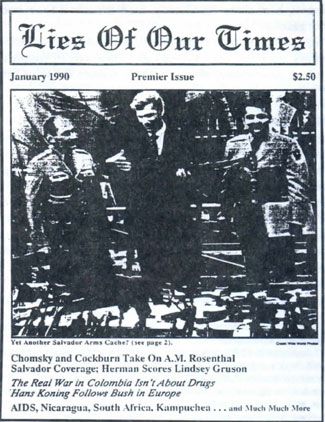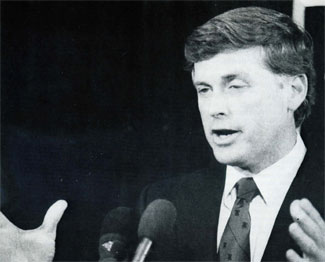by Debra Evenson *
Winter 1990
NOTICE: THIS WORK MAY BE PROTECTED BY COPYRIGHT
YOU ARE REQUIRED TO READ THE COPYRIGHT NOTICE AT THIS LINK BEFORE YOU READ THE FOLLOWING WORK, THAT IS AVAILABLE SOLELY FOR PRIVATE STUDY, SCHOLARSHIP OR RESEARCH PURSUANT TO 17 U.S.C. SECTION 107 AND 108. IN THE EVENT THAT THE LIBRARY DETERMINES THAT UNLAWFUL COPYING OF THIS WORK HAS OCCURRED, THE LIBRARY HAS THE RIGHT TO BLOCK THE I.P. ADDRESS AT WHICH THE UNLAWFUL COPYING APPEARED TO HAVE OCCURRED. THANK YOU FOR RESPECTING THE RIGHTS OF COPYRIGHT OWNERS.
"That's a Cuban cigar. You see where it come from? Havana." Reinaldo Ruiz, an imposing man six feet four inches in height and weighing 270 pounds, sat in the Miami office of a Drug Enforcement Administration (DEA) informant in mid- 1987 and bragged about transporting cocaine shipments from Colombia through Cuba with the help of "top" Cuban officials. [1] The DEA informant, Hu Chang, was well aware of Ruiz's contacts in Cuba since he himself had flown the first successful transshipment for Ruiz from Colombia to Cuba on May 9, 1987. [2] Nor was Chang new to the drug trade. A former Nationalist Chinese air force pilot who had worked as a contract pilot for the CIA in Southeast Asia, Chang had been arrested on drug smuggling charges shortly after immigrating to the U.S. in 1979. [3] The collaboration between these two men initiated the first proven involvement of Cuban officials in international drug trafficking.
For years the U.S. accused Cuba of trafficking in drugs but never had credible evidence to back its accusations. [4] Reinaldo Ruiz provided that opportunity. When Ruiz persuaded a young relative working for the Cuban Ministry of Interior (MININT) to arrange use of Cuba as a transit point in 1987, U.S. law enforcement officials tracked the operation from its inception, taping the conversations among the participants.
The information DEA obtained was never shared with the Cuban government, which did not uncover the drug-dealing operations on its own until the spring of 1989. Then the Cuban government moved quickly to expose the scandal and to prosecute the officials involved. But rather than praise the Cubans for taking decisive steps to stop drug trafficking, the Bush administration harshened its public repudiation of Cuba and rejected Cuba's offers to cooperate in drug interdiction.
What Did the U.S. Know?
The facts raise many questions about the involvement of U.S. agencies in the Cuba drug operation. They also call into question whether the Bush administration is more concerned with anti-communism than it is with interdicting drug traffic.
Reinaldo Ruiz left Cuba in 1962 at about age 25. By 1986, he was living comfortably in Los Angeles where he owned two homes worth more than $800,000. One apparent source of income was a business he operated out of Panama called Colombian Tours, SA., which arranged travel to and from Cuba. To carry out some of his business arrangements with Cuba, Ruiz contracted for the legal services of Interconsult, a Cuban office in Panama. Coincidentally, Miguel Ruiz Poo, the 34-yearold son of Ruiz's cousin, happened to be a captain in the Cuban Ministry of Interior functioning as manager of the Interconsult office in Panama. In the fall of 1986 Ruiz went to the Interconsult offices to look up his young relative.
After establishing a relationship with Ruiz Poo, Reinaldo began to suggest business deals in which he would acquire various blockaded equipment for the Cubans, proposals which Ruiz Poo passed on to his superior, Amado Padron, who was in charge of Cuban intelligence activities in Panama. As these discussions progressed, Reinaldo introduced the idea of drug shipments through Cuba. He told Ruiz Poo that his girl friend, Ligia Cruz, a Colombian, could obtain cocaine through her connections to Gustavo Gaviria, a cousin of Medellin cartel boss Pablo Escobar Gaviria, and through contacts in Miami, Ruiz could arrange for the drugs to be picked up by speedboats and taken to Florida. Thus, if Miguel Ruiz Poo could arrange a transshipment base in Cuba, Reinaldo Ruiz could take care of getting the drugs to and from Cuba. Ruiz Poo took the proposal to Padron, and the three met in Panama in late 1986 to discuss the scheme.
A few weeks later, Ruiz flew to Cuba to meet with Padron and Tony de la Guardia, the chief of the special MC department set up by the Cuban Ministry of Interior in 1986 to break the U.S. trade blockade by obtaining U.S. goods in Miami and elsewhere and getting them into Cuba. [5] These operations frequently involved receiving clandestine Shipments by plane or by speed boats coming from Miami. On de la Guardia's order alone, the coast and landing strips were cleared for receipt of these shipments which were unloaded only by members of the MC department. So the mechanism by which Cuba could be used as a transit base for drugs without the knowledge of officials outside the MC department was already in place when Ruiz proposed his deal.
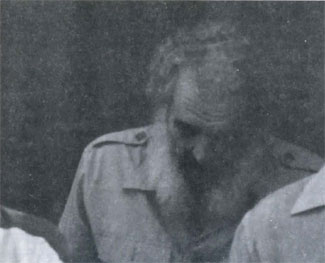
Credit: Wide World Photos
Reinaldo Ruiz, convicted drug smuggler.
Arrangements were made for a first operation to take place in January 1987. Ruiz purportedly sent his plane to Colombia for the drugs, the speedboats arrived from Miami, but the plane never came. Perhaps Ruiz was just testing his Cuban counterparts; he told them problems with the airplane caused the operation to be aborted.
A second operation was planned for April 10, 1987. As early as October 1986, Ruiz had established a relationship with Hugo Ceballos, a Colombian living in Miami who was looking for ways to transship cocaine from Colombia to Florida. Ceballos worked with a group of Miami-based speedboat operators. According to U.S. legal documents, Reinaldo's son Ruben Ruiz and an American co-pilot named Richard Zzie flew Ruiz's plane from Florida to Panama on March 28. On April 10, they flew from Panama to Colombia, picked up about 400 kilograms of cocaine and landed the shipment at Cuba's Varadero airport concealed in boxes of Marlboro cigarettes.6 The boxes were then loaded onto speedboats which had arrived from Florida. The U.S. Coast Guard intercepted the boats as they entered U.S. waters.
Later, in a "secretly" recorded videotape, Ruben Ruiz bragged about how the Cubans "tricked" U.S. customs officials in Fort Lauderdale by calling ahead and reporting that Ruiz's plane had had engine difficulty forcing it to land in Varadero. [7] Thus, according to Ruben, U.S. Customs did not give them any trouble for coming in from Cuba. However, given the constant accusations of Cuban complicity with drug trafficking, it is inconceivable that U.S. Customs would not closely scrutinize an unscheduled plane coming from Cuba no matter what the reason given. The most plausible explanation is not that the Cubans were able to give Ruiz cover, but that U.S. officials knew full well where the plane had been and were not going to interfere with the activities of Ruiz.
Only on the third try, in May 1987, did the operation succeed. This time DEA agent Chang co-piloted the plane with Ruben Ruiz. The drugs arrived in Cuba packed in Epson computer boxes, were repacked into cigar boxes and loaded onto waiting speedboats which took the shipment to Florida. The plane flew from Cuba to Merida, Mexico, before returning to Miami. After this operation, the MININT officials involved decided to stop the operation for the rest of the year; Ruiz ceased his dealings with Cuba and moved his operations to Haiti. The four Cuban officials involved had received a total of approximately $400,000 from their deal with Ruiz.
The DEA, and probably the CIA, were both involved in and knowledgeable of these operations as early as the summer of 1986, when a DEA undercover agent infiltrated Ceballos's organization. Coincidentally, in late July Ruben Ruiz purchased a Cessna 401 aircraft which was used to transport the drug shipments. It is not clear from the court documents in the case how Ceballos was put in contact with Ruiz, but according to the documents, U.S. law enforcement officials were aware that Ceballos and Ruiz met at least as early as October 1986, which is about the same time that Ruiz approached his Cuban relative Ruiz Poo. Meetings among the U.S.-based participants were held at Chang's offices in Miami which were recorded on videotape.
In February 1988 Ruiz and his co-conspirators including his son Ruben Ruiz were indicted by a Federal Grand Jury in Miami. [8] At the same time, Hugo Ceballos and 10 others were arrested under a separate indictment. [9] In July 1988, Ceballos and his cohort involved in smuggling the drugs into Florida were convicted. [10] Eight months later, in early March 1989, Ruiz and his son pleaded guilty, but were not sentenced until late August, more than a month after the Cuban government had convicted and sentenced the officials involved.
Although the February 1988 indictments in the Ruiz/Ceballos cases alleged use of Cuba as a transshipment point, the Cuban government denied the allegations of official involvement as just so much more U.S. propaganda. There was nothing to distinguish such allegations from the barrage of previous accusations which the Cubans claimed were patent- 1y false. Among the evidence proffered to show the Cuban connection was one of the "secretly" recorded videotapes made at Chang's office.
In the portion of the tape which was played at Reinaldo Ruiz's bond hearing in March 1988, Ruiz says "the drug money went into Fidel's drawer." Though Ruiz admitted afterwards that he had no actual knowledge of Fidel Castro's involvement, the taped statement made headlines in the U.S. press. [11] To the Cuban government, however, the allegation was specious and provided convincing evidence that the charges were unfounded.
Cuban Suspicions Arise
It was not until the trial of Hugo Ceballos in July 1988 that Cuban intelligence began to take interest in the allegations. Ceballos did not have direct contacts with Cuban officials, but evidence presented at his trial suggested use of Cuban territorial waters for drug shipments. Although the testimony regarding Cuban connections was not specific, Cuban diplomats nevertheless approached officials of the DEA to request an exchange of information. DEA officials in Miami were interested in exploring such an exchange and took the proposal to the State Department where it was tacitly rejected. [12] The rejection may have further convinced the Cubans that the U.S. had no concrete evidence to share. In any event, left with nothing more than unsubstantiated general statements in the context of a virulently hostile propaganda campaign, Cuba undertook no further investigation of its own at that time.
According to Granma, the newspaper of the Cuban Communist Party, Cuba began its investigation when it received reliable information from friendly diplomats in March 1989. [13] State Department representatives in Havana have claimed that they had attempted to provide information to the Cuban government in 1988, but that their warnings were ignored. [14] However, in briefing a House Narcotics Subcommittee delegation bound for Cuba to discuss drug-related issues with Fidel Castro, State Department officials in Washington advised in December 1988 that the U.S. was not cooperating with the Cubans on narcotics matters either officially or unofficially. [15] Obviously, if the Bush administration was interested in furthering its purported effort to inform the Cubans, it would have solicited the aid of the House delegation, and at a minimum advised them of the situation.
It is evident that the U.S. did not want to hasten the Cuban probe into drug dealing, and some U.S. law enforcement officials have expressly stated that the Miami investigation did not provide the informational basis for the Cuban investigation. Indeed, only after Cuba completed its own investigation did the DEA admit that although it had the names of the Cuban officials working with Ruiz, these names were never released in public documents nor given to Cuba. DEA's claims that it had uncovered these names by October 1988 are disingenuous. Since its own agents were involved even before Ruiz made contact with the Cubans and a DEA agent participated in landing drugs in Cuba, DEA knew the names of these contacts from the very beginning.
The Arrests in Cuba
In June 1989, the Cuban government arrested 14 military officials including 11 Ministry of Interior officers on charges of corruption and drug trafficking. Among those arrested were the three officers who dealt with Reinaldo Ruiz in 1987. [16] Despite the substantial amount of information compiled by DEA from July 1986 to the present on the Ruiz/Cuba connection, Johnny Phelps, assistant special agent in charge of the DEA office in Miami, told the press after the announcement of the Cuban arrests that "there's nothing at this point to say that there is [a connection between the two operations]." [17] The U.S. continued to conceal the facts it had in its possession.
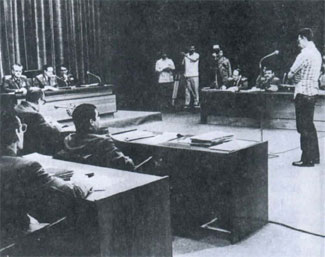
Credit: Prensa Latina
General Arnaldo Ochoa testifying at the military trial.
An explanation for the Reagan/Bush administrations' refusal to share information with the Cubans surfaced on the editorial page of the Wall Street Journal on September 25. According to an Op-Ed piece by David Asman, the CIA sent operatives into Cuba on several occasions after the arrest of Reinaldo Ruiz in attempts to get Tony de la Guardia and Miguel Ruiz Poo out before they were arrested by the Cuban government. Rescuing drug traffickers from trial in their native country is an odd tactic in the "war on drugs," but it is consistent with the objective of preventing Cuba from learning the full facts about the drug operations.
When Cuba arrested 14 officials, the Bush administration had the audacity to insist it had a right to interview the defendants.
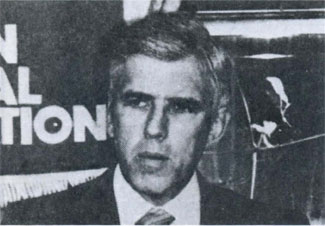
Credit: CANF
Then-DEA Director Frances Mullen speaking at the extreme rightwing Cuban American National Foundation.
Not only did Cuba uncover the facts despite the U.S. concealment, the Cuban investigation went much further than the DEA's and uncovered operations involving other Cuban-Americans based in Miami who had engaged the cooperation of the Cuban officials convicted. There are no reports that these Miami dealers have been arrested or indicted in the U.S.
The Trials in Cuba and Miami
In the more than eight days of televised court proceedings, the Cuban population learned in detail how the special MININT division secretly set up to break the U.S. trade blockade became involved in drug smuggling. At the same time evidence described how three members of the Cuban Armed Forces (FAR) assigned to Angola, including popular military hero Division General Arnaldo Ochoa, unsuccessfully tried to arrange a drug deal with Medellin drug cartel boss Pablo Escobar in an escapade which seriously threatened Cuban national security.
Although all the defendants confessed to the charges, under Cuban law, like many other civil law systems, a guilty plea does not obviate a trial. The state must still demonstrate independent evidence of guilt and present argument for sentencing. In this case, the corroborating evidence consisted of the testimony of other defendants and witnesses, stashes of cash, drugs and documentary evidence.
At the end of the trial, the prosecutor requested the death penalty for seven defendants. The three-judge military court sentenced to death the four highest ranking officials who had directed the operations, and with one exception sentenced the others to 25-30 years imprisonment. [18]
In Miami, both Reinaldo and Ruben Ruiz were given reduced sentences for their "cooperation" with the prosecution. For his part, Reinaldo Ruiz, who initiated the operation was sentenced on August 21st to 17 years imprisonment with the possibility of parole in 1993. Under the new sentencing guidelines which went into effect on November 1, 1987, Ruiz should have received life in prison, but government lawyers moved that the guidelines not apply to Ruiz, conceding that his criminal activity ended prior to that date. Interestingly, the indictment alleges criminal activity through mid-February 1988. Ruben Ruiz was sentenced to 15 years in prison.
Although Reinaldo Ruiz received leniency on the basis of post-arrest cooperation, the record suggests that the information yielded by Ruiz was available to the DEA throughout the criminal conspiracy in 1986 and 1987. No significant new information emerged after arrest. Could it be that Ruiz's "cooperation" began in 1986 before he contacted his Cuban cousin?
The Disinformation Campaign Continues
In the tradition of spurious allegations and exaggerations which has characterized the U.S. propaganda campaign against Cuba since 1960, some U.S. officials, anti-Castro exile groups, and members of the establishment press launched an attack marked as much by inconsistency as by preposterous lies and speculation. Among the baseless allegations most popularized by the U.S. media were charges that 1) the prosecutions were merely a "show" trial to cover up a political purge; 2) the trafficking was directed or at least condoned by Fidel Castro himself; 3) the Cubans knew of the Cuban involvement in 1988 when the U.S.-based connections were indicted in Miami and did nothing to stop the operations; and 4) Cuba continues to cooperate with drug smuggling operations.
Among the more specious invectives was the charge that the Cuban prosecutions were merely a "show" trial to cover up a political purge. Although the evidence manifestly contradicts such speculation and U.S. intelligence officials were reported by Newsweek International to have rejected such assertions as unfounded, 19 U.S.-funded Radio Marti broadcast daily bulletins to Cuba alleging that the drug charges were groundless and that Ochoa and the others were being pilloried for plotting against Castro. That Radio Marti would broadcast such an obvious lie to the very audience with which it tries to establish credibility is astonishing. But, then, the U.S. national press put forth similar allegations as news reporting. [20]
The proponents of the "purge" theory apparently want it both ways: They chastise Cuba for refusing to acknowledge drug trafficking by its officers, but when Cuba prosecutes drug traffickers, they accuse Cuba of masking a political plot against the government. If Fidel Castro wanted to purge officers, he did not need to risk his credibility by exposing Cuban involvement in drug trafficking which he had long denied. Moreover, much of the evidence in the case against the MININT officers closely paralleled evidence in the Ruiz/Ceballos cases, and prosecution was limited to the MININT officers working for the special MC department and three FAR officers. The evidence of drug trafficking was both detailed and compelling.
A prominent component of the propaganda campaign is the assertion that the trafficking was directed or at least condoned by Fidel Castro himself. According to this theory, the prosecution of high ranking officials was, therefore, just a maneuver to dissociate Castro from the drug activities. No evidence has been offered to substantiate such a claim. Indeed, the facts make such a charge highly implausible and it has been rejected by prominent Castro biographers Gianni Mina and Tad Szulc. [21]
First, the quantity of drug transshipments by way of Cuba even at the height of the operations was relatively insignificant, hardly worth the effort, given the likelihood of detection by the U.S. If Fidel Castro was really engaged in drug trafficking, why wouldn't he make the most of it? Cuba lies directly in the path of Latin American cocaine producers and the primary port of entry into the United States, Florida. Why be involved in penny-ante isolated efforts which could not in the least give the Cuban economy the support the U.S. claimed it was seeking through such illegal activity? The evidence at the recent trial in Cuba suggests that from 1987 to April 1989, Cubans received only $3 million for all their efforts and much of this was taken for the private use of the officials prosecuted. Castro would never have risked his prestige and the prestige of the revolution for so little.
Moreover, it is no secret that where there is drug trafficking the CIA is often close at hand. The CIA was undoubtedly aware of the MC operations to break the blockade. In late 1986 and 1987, contacts in Panama and Miami suggested to the MC officials that the MC initiative could be aided financially by allowing Cuba to be used as a transshipment base for drugs. To permit Cuban territory to be used as a transshipment base invites CIA involvement and infiltration. And indeed, a CIA operative flew one of the first cocaine-laden planes which landed at the military airport at Varadero Beach in 1987.
Further, it appears that Ruiz, if not an agent himself, cooperated with the CIA to send an operative to Cuba to attempt to get Tony de la Guardia and Miguel Ruiz Poo to defect before they were arrested. [22] It is not inconceivable that some of the drug operations were initiated by CIA connections, but it is inconceivable that Castro would willingly compromise Cuban security to such an extent.
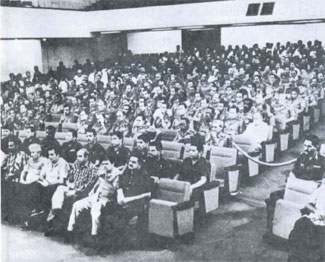
Credit: Prensa Latina
Audience listens to testimony at the trial of Cuban military officials.
Second, those involved had a convincing cover which hid their drug activities from higher officials. As director of the special MC department - the mission of which was to bring blockaded goods into Cuba-Tony de la Guardia and other members of the department established operations in Panama to purchase U.S. goods. Since sale of such goods to Cuba violated U.S. Treasury Department regulations, the goods had to be obtained through secret channels. Some of the goods came into Cuba by speedboat from Miami and by air from Panama and Colombia. In order to achieve their objectives in secret, de la Guardia and company had to have authority to permit such boats and planes to enter Cuban territory without interference by the Coast Guard. To further the cover, drugs arrived in boxes marked "Epson Computers" or other blockaded goods. After reviewing the evidence, even U.S. diplomats in Havana gave credence to Cuba's claim that Castro did not know about the operations. [23]
Third, such involvement is contrary to Cuban interests in maintaining international prestige and in improving relations with the United States. Since Cuba is hopeful of loosening the trade embargo to help its economy, it would be irrational to play into U.S. propaganda used to justify the continuation of the blockade.
The latest version of the "Castro connection" asserts that Fidel Castro's brother and Cuban Defense Minister, Raul Castro, took part in the operation. The support for this accusation came from confessed smuggler Reinaldo Ruiz as he was about to be sentenced this past summer. [24] Ruiz, who initiated the first drug operation with the Cubans, was purportedly facing a life sentence for his involvement but after his "cooperation" with prosecutors he received only 17 years with eligibility for parole in 1993 (only four years' time) and a promise from the judge that his sentence could be further reduced if he continued his "cooperation." How coincidental that as he is about to be sentenced months after he pleaded guilty he suddenly remembered that he saw Raul Castro at the airport when one of Ruiz's cocaine shipments was unloaded at a military airfield in 1987. [25]
With Cuba now taking firm measures to prevent any reoccurrences of Cuban nationals cooperating with drug traffickers, the Bush administration will probably stretch spurious charges as far as it can. And with nothing to lose but time in jail, Ruiz will probably come forth with additional revelations which cannot be corroborated.
Is Cuba Now Engaged in Drug Trafficking?
Although there appears to be some evidence that drugs have been transported near or through Cuban territorial waters and over Cuban airspace since June, such facts alone do not implicate Cuban involvement any more than they would implicate the governments of all countries lying along known drug shipment routes. There is no evidence of any Cuban cooperation with these shipments. The harm done to Cuba by the recent scandal was substantial. To risk additional harm to national security and prestige by continuing such operations simply does not make sense. The harsh sentences handed down by the Cuban military court were a clear warning to any others who might engage in such ventures.
Elliott Abrams suggests that if the Cubans are really serious about stopping drug trafficking, they should shoot down planes flying over their territory without authorization. It is not difficult to predict the U.S. reaction here if Cuba shot down an innocent plane.
Cuba persists in its effort to enter into cooperative agreements on drug interdiction with the U.S. The Bush administration has responded by tightening the economic embargo and seeking further restrictions on travel between the two countries. In criticizing the Bush administration for rejecting Cuba's offers, Representative Charles B. Rangel (Dem.-New York), chair of the House Select Committee on Narcotics Abuse and Control put the issue bluntly: "It's time for the State Department to stop playing anti-Communist politics. It's drugs, not Communists, that are killing our kids."
_______________
Notes:
* Debra Evenson is an Associate Professor of Law at DePaul University College of Law and the President of the National Lawyers Guild; copyright © 1989 by Debra Evenson and Covert Action Publications, Inc.
1. The statement was made in a videotape played at Reinaldo Ruiz's pretrial detention hearing in Federal District Court, Southern District of Florida on March 9, 1988; Washington Past, March 10, 1988, p. A18.
2. Chang's involvement is reported both in the indictment of Reinaldo Ruiz and in the Miami Herald, July 9,1989, p. 1A.
3. lbid.
4. U.S. law enforcement officials acknowledged this in a Washington Post story following the trial of drug smugglers with alleged connections to Cuba. Washington Past, July 26, 1988, p. A4. See also, CovertAction Information Bulletin, No. 19 (Spring-Summer 1983), pp. 9-11.
5. The United States imposed a partial trade blockade on Cuba in 1960 which was extended in 1961 to include almost all U.S. goods with the exception of some foodstuffs and medicines. By 1964, the U.S. had pressured the OAS to join the blockade. Most Latin American allies of the U.S. joined with the notable exception of Mexico. Today, most Latin American countries have lifted the blockade and have re-established diplomatic relations with Cuba. The U.S., however, has extended its economic embargo under the Reagan and Bush administrations, including the restriction of travel by U.S. citizens to Cuba.
In order to get needed parts and goods, the Cuban Ministry of Interior (MININT) set up the MC Department within MININT to find ways to obtain blockaded goods.
6. Marlboro cigarettes are one of the primary brands of U.S. cigarettes brought into Cuba to be sold in tourist and diplomat stores.
7. Ruben Ruiz also liked to boast of his terrorist skills. According to the transcript of Reinaldo Ruiz's pre-detention hearing, he had been taped as saying that he was expert in blowing up cars.
8. Indictment No. 88·127, United States District Court for the Southern District of Florida.
9. Indictment No. 88-126, United States District Court for the Southern District of Florida.
10. Ceballos was sentenced to 30 years on each of 5 counts of importing and distributing cocaine, the sentences to run concurrently.
11. Washington Post, March 10, 1988, p. A18; Miami Herald, March 10, 1988, p. 4C.
12. The account of this thwarted attempt at cooperation was reported in the Miami Herald, July 9, 1989, p. 1A. DEA's request was simply shelved by the State Department.
13. The recent trial of former Minister of Interior Jose Abrantes Fernandez revealed that Abrantes had received a report from one of his officers in late February 1989 suggesting that some MININT officials might be involved in drug trafficking. When Abrantes failed to act on the information, it went no further. Since prosecutors could not prove that Abrantes deliberately furthered the drug scheme, he was not charged with involvement in the drug operations and thus not subject to the death sentence. He was sentenced to 20 years imprisonment for abuse of office, negligence in service and unauthorized use of financial resources belonging to the ministry.
14. Washington Post, July 25,1989, p. A17.
15. Jeff Leen, Miami Herald, July 9, 1989, p. 1A.
16. Even after the Cubans arrested the officials and publicized their names, U.S. Attorney Dexter Lehtinen in charge of the Miami cases would not reveal the names of the Cuban officers identified in the U.S. investigations.
17. Miami Herald, July 9, 1989, p. 1A
18. Under Cuban law, a death sentence must be reviewed by the Supreme Court and the Council of State before it can be executed. Both institutions reaffirmed the sentences in this case. Because of the critical significance of the trial and its consequences both domestically and internationally, the 29 members of the Council of State publicly explained their individual reasons for affirming the death sentences.
19. Newsweek International, July 10, 1989.
20. Julia Preston, "Cuba Sentences Officers to Death for Corruption; General's Dealings Circumvented Castro," Washington Post, July 8, 1989, p. A1.
21. "Juicio a Fidel, entrevistas con sus biografos," Proceso, September 18, 1989.
22. Wall Street Journal, September 25, 1989.
23. Washington Post, July 24, 1989, p. A17.
24. Ruiz was Originally scheduled to be sentenced in May. Sentencing was delayed until July. Although the reason for the delay has not been made public, it is probable that it was related to the trial in Cuba. Sentencing was again postponed in early August, purportedly due to Ruiz's health problems. After the sentencing which took place on August 21, enforcement officials disclosed Ruiz's allegation that he saw Raul Castro at the military base where he landed one of the planes. Miami Herald, August 22, 1989, p. 1B.
25. Since Ruiz's account of Raul Castro's possible involvement, another Cuban American indicted in a separate drug trafficking operation has stated that Raul Castro approved the operations. No doubt many more drug smugglers will make such revelations since the payoff in reduced sentences is such an attractive incentive.

